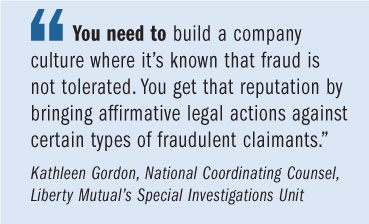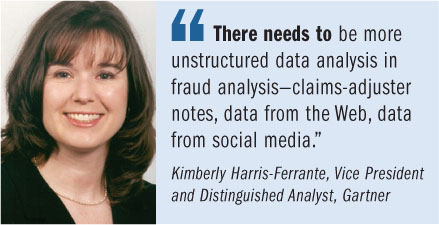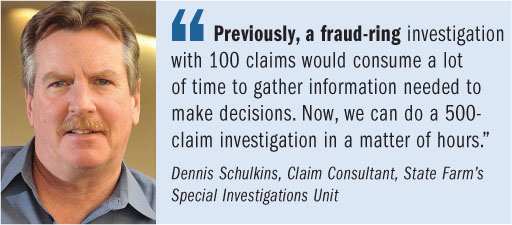 It's tough to find much to beoptimistic about when considering insurance-fraud statistics.
It's tough to find much to beoptimistic about when considering insurance-fraud statistics.
The National Insurance Crime Bureau (NICB) reports a recordnumber of questionable claims in 2011. Consumer tolerance of fraudis also increasing, with the Coalition Against Insurance Fraud(CAIF) reporting that over the past 10 years, fewer Americans thinkit is unethical to inflate claims or misrepresent facts to gaincoverage.
|But even while insurers lose ground on the battlefield, theyknow they have to keep up the fight against fraud. Humaninvestigation is indispensable to the effort, but a best-practicesapproach demands technology as well.
|"You can't do fraud investigation without accessing data,without having tools to analyze data and without having analysts touse those tools," says Dennis Schulkins, claim consultant in StateFarm's special investigations unit (SIU).
|SOCIAL MEDIA & SURVEILLANCE CAMS: NEW TOOLS FORDISCOVERY
|"There needs to be more unstructured data analysis in fraudanalysis—and by that, I mean claims-adjuster notes, data from theWeb, data from social media," says Kimberly Harris-Ferrante, vicepresident and distinguished analyst at IT research and advisorycompany Gartner.
|Social media has been a hot topic within SIUs in recent months.With nearly two-thirds of adults maintaining profiles onsocial-networking sites, mining social data for evidence ofactivity that contradicts a statement of injury or loss can beinvaluable in preventing fraudulent claims from being paid.
|"People are very quick to post all kinds of information and saysome things [in social media] that they probably shouldn't have,"says Mike Butler, commercial market SIU manager for LibertyMutual.
|About a year ago, Secura Insurance hired a dedicatedsocial-media investigator. In one case, the insurer found that anindividual claiming he could no longer golf had posted publicly onFacebook about being a member of the latest championship team athis country club. In another, a person claiming total disabilityposted pictures of himself riding a skateboard. In both instances,social-media data helped Secura resolve the case.
|The proliferation of surveillance technology today has also beena boon to SIUs.
|"There are cameras everywhere. They aren't thesilver bullet, but they do provide evidence," says Butler. In arecent case, Liberty Mutual was able to utilize traffic-cameraimages to prove that a person claiming to be injured in an accidentwas not in the vehicle.
|OLD MODEL, FRESH APPLICATION
|Despite the role of a surveillance camera in the aformentionedcase, Liberty Mutual still gets more bang for its SIU buck frommore  traditional data-crunching andworkflow technologies.
traditional data-crunching andworkflow technologies.
Like many carriers, it has a red-flag system to bring suspiciousclaims to adjusters' attention; the difference is that LibertyMutual uses an internally built fraud model to set flags.
|The company is understandably circumspect in how much detail itwill reveal about its propriety model, but it reports that itleverages its extensive book of Workers' Comp business to providerelevant data.
|"Using [claim attributes] that are established red flags in theindustry is just the start," says Steve Friedman, national directorof special investigations for Liberty Mutual Agency Corp. "We usepredictive modeling to create a model that is forever adapting,from first notice all the way through the life of the claim."
|Gartner's Harris-Ferrante confirms that in today's environment,creating an effective fraud model is not a "set-it-and-forget-it"activity.
|"Fraudsters get smarter over time, so you need a cycle wherefraud is identified and confirmed, and it becomes a learningprocess. You need to be open to identifying newmodels—understanding that there might be better triggers that aredetermined through data analysis or investigation of outliers," shesays.
|At State Farm, the evolution and adoption of link-analysistools, which detect trends across hundreds or thousands of claims,has increased the company's ability to combat organized fraud.
|"Previously, a fraud-ring investigation with 100 claims wouldconsume a lot of time to gather information needed to makedecisions. Now, we can do a 500-claim investigation in a matter ofhours," reports Schulkins.
|Although State Farm won't disclose the specific third-partyanalysis platforms it has chosen, Schulkins says these tools havebecome essential.
|"[Fraudsters] have become more sophisticatedin hiding their schemes," he explains. "The tools will not make aclaim decision for you, but they give the decision-maker the mostrelevant information quickly."
|FIGHTING ON MULTIPLE FRONTS
For its part, Nationwide believes that fraud-fighting is closelytied to reducing overall theft losses, which is why both activitiesfall under the company's SIU.
|"We're here to protect the consumer, and it doesn't matter if[those consumers are] our customers or the general public," saysLynne Brady, associate vice president of special investigations atNationwide.
|One of Nationwide's more successful initiatives is itsbait-vehicle program, consisting of more than 70 vehicles in 19different states that are hot among thieves.
|Nationwide analyzes its own loss data to determine where thereis significant theft, then partners with different local, state andnational agencies to supply bait cars. Technology allows vehiclesto be driven a short distance by thieves before they areautomatically locked down, with their location transmitted via GPSto law enforcement.
|"There have been over 400 arrests [due to the program], and incertain areas we've seen theft go down anywhere from 20-60percent," says Brady.
|In addition to the bait-vehicle deterrent program, Nationwideuses post-claim technology in its SIU and throughout its claimsoperations, including license-plate reader (LPR) cameras.
|"We have been able to recover hundreds of vehicles, not justNationwide's [insured] vehicles" in the LPR program, Bradyadds.
| Although designed primarily toreduce theft loss, programs such as these enhance a company'sreputation of being "tough on crime," which can positively impactfraud-fighting efforts. Data supports this strategy: More thantwo-thirds of consumers say they believe insurance fraud happensbecause people believe they can get away with it, according tostatistics cited by CAIF.
Although designed primarily toreduce theft loss, programs such as these enhance a company'sreputation of being "tough on crime," which can positively impactfraud-fighting efforts. Data supports this strategy: More thantwo-thirds of consumers say they believe insurance fraud happensbecause people believe they can get away with it, according tostatistics cited by CAIF.
"You need to build a company culture where it's known that fraudis not tolerated. You get that reputation by bringing affirmativelegal actions against certain types of fraudulent claimants," saysKathleen Gordon, national coordinating counsel of Liberty Mutual'sSIU.
|Ultimately, investigators understand that technology is just aweapon in their fraud-fighting arsenals. "All of thesetools provide information, trends, behavioral comparisons and soon," says Schulkins. "But in the end, those are just leads to pointyou in the direction of where you need to deploy humanmanpower."
Want to continue reading?
Become a Free PropertyCasualty360 Digital Reader
Your access to unlimited PropertyCasualty360 content isn’t changing.
Once you are an ALM digital member, you’ll receive:
- All PropertyCasualty360.com news coverage, best practices, and in-depth analysis.
- Educational webcasts, resources from industry leaders, and informative newsletters.
- Other award-winning websites including BenefitsPRO.com and ThinkAdvisor.com.
Already have an account? Sign In
© 2024 ALM Global, LLC, All Rights Reserved. Request academic re-use from www.copyright.com. All other uses, submit a request to [email protected]. For more information visit Asset & Logo Licensing.








